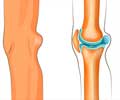Orthopedic surgeons at Rush University have developed the first knee replacement shaped to fit a woman's anatomy
Orthopedic surgeons at Rush University have developed the first knee replacement shaped to fit a woman's anatomy. IIt has received clearance from the U.S. Food and Drug Administration, and will be distributed to orthopedic surgeons to use next week. Dr. Aaron G. Rosenberg and Dr. Richard A. Berger, orthopedic surgeons were two of the 10 developer surgeons who sought to address shape-related differences of a woman’s knee.
The Gender Solutions High-Flex Knee, made by Zimmer, Inc, is designed based on three distinct and scientifically documented shape differences between women's and men’s knees. The implant addresses the shape-related differences typical of a woman's knee: a narrower shape; thinner shape, and the need for more natural motion for the knee when walking.‘Knee implants have been functioning very well for men and women, but we want to meet women's unique needs by making knee replacements that feel, fit and function even better,’ says Rosenberg. ‘The implant is the best of both worlds. It's based on the current implant we use, a highly successful implant with great mechanics and 10 years of clinical success. Only the shape of this new implant is different, to make it feel more natural.’
The clearance allows Zimmer to begin distributing the implant to U.S. orthopedic surgeons and hospitals as part of Zimmer’s NexGen Complete Knee System. The Gender Solutions Knee will be implanted using existing, clinically successful surgical techniques, including Zimmer's minimally invasive approaches. Rosenberg and other surgeons who helped with development will be using the implant in patients next week. The implant is expected to be globally available this fall.
The Need for a Woman’s Knee Implant ‘Mounting research indicates that a woman’s knee is not simply a smaller version of a man’s knee. The differences involve the bones, ligaments and tendons in the joints,’ says Rosenberg. ‘Women can wear men’s clothing and shoes, but most prefer clothing and shoes made for them. It’s the same with knees, and it makes perfect sense to design knee implants with women in mind, particularly considering that women are by far the majority of the knee replacement patient population.’
Nearly two-thirds of the more than 400,000 annual knee replacement patients are women, according to the National Center for Health Statistics, and the numbers continue to increase each year. Research shows that while both women and men vastly under use knee replacement, women are three times less likely than men to undergo the procedure, although they suffer from more knee pain and resulting disability.
‘Less invasive procedures are helping patients get back to enjoying their lives faster than ever before. Now that we have a knee shaped to fit women’s anatomy, we expect far more women will want to consider knee replacement.’
Advertisement
The female implant can be placed using minimally invasive techniques which typically offer smaller scars, shorter hospitalization and quicker rehabilitation and recovery; and safely accommodates high flexion (up to 155 degrees), which is necessary for many activities, such as climbing stairs, sitting in a chair, gardening and golfing.
Advertisement
Historically, implants used for knee replacement have been designed based upon an average between the size of women’s and men’s knees. Total knee replacement is a highly successful surgery, strongly supported by more than 20 years of follow-up data, according to the National Institutes of Health (NIH) consensus statement on total knee replacement released in February 2004. The NIH consensus panel concluded that total knee replacement provides substantial improvement in patients’ pain, functional status, and overall health-related quality of life in about nine out of 10 patients.
Three Distinct Differences The Gender Solutions implant addresses the following research-documented, shape-related differences of a woman's knee:
Narrower Shape, Proportioned to Female Anatomy: When determining the appropriate-sized implant, surgeons measure the end of the femur from front to back and from side to side. Women’s knees typically are narrower from side to side, and are more trapezoid-shaped, whereas men’s knees are more rectangle-shaped. Surgeons typically choose the implant size based on the front-to-back measurement, which is key in allowing the knee to move and flex properly. However, an implant that fits a woman’s knee from front to back often will be too wide from side to side, leading to the implant overhanging the bone and potentially pressing on, or damaging, surrounding ligaments and tendons, possibly causing pain. The Gender Solutions knee is proportionally contoured to the entire bone to provide a more precise fit.
Thinner Shape: The bone in the front of a woman's knee is typically less prominent than in a man's knee. Therefore, when a traditional implant is used to replace the damaged bone, the joint may end up feeling and functioning better than before surgery but still feel ‘bulky,’ which may result in pain and decrease optimal function. This implant is thinner in shape in the front so the knee replacement more appropriately matches the natural female anatomy.
More Natural Tracking: The angle between the pelvis and the knee affects how the kneecap tracks over the end of the femur as the knee moves through a range of motion. Women tend to have a different angle than men due to their specific shape and contour. The Gender Solutions Knee Implant was designed to accommodate the different tracking angle and function more like a woman's natural knee.
Source: Eurekalert








